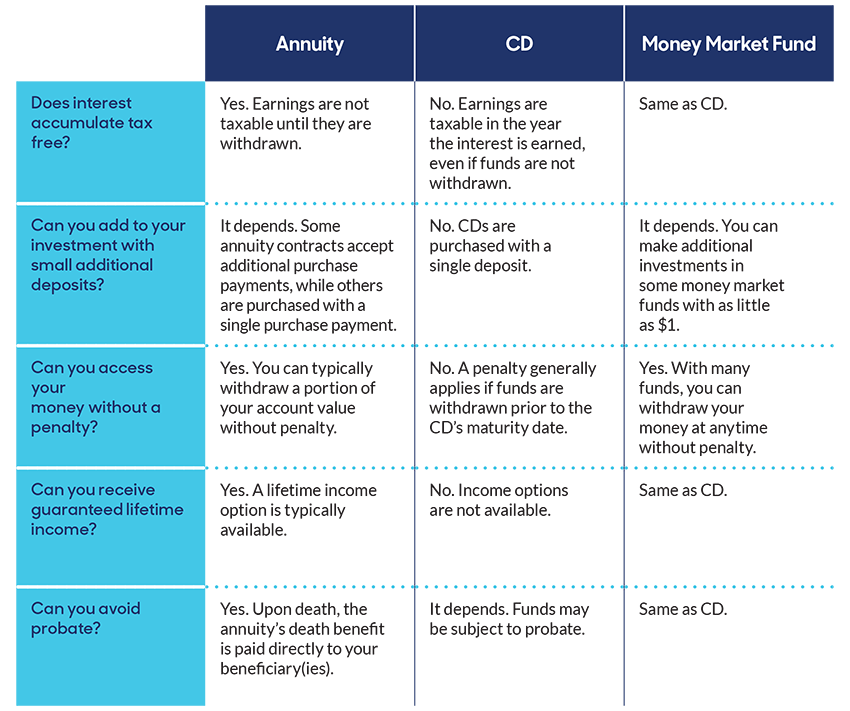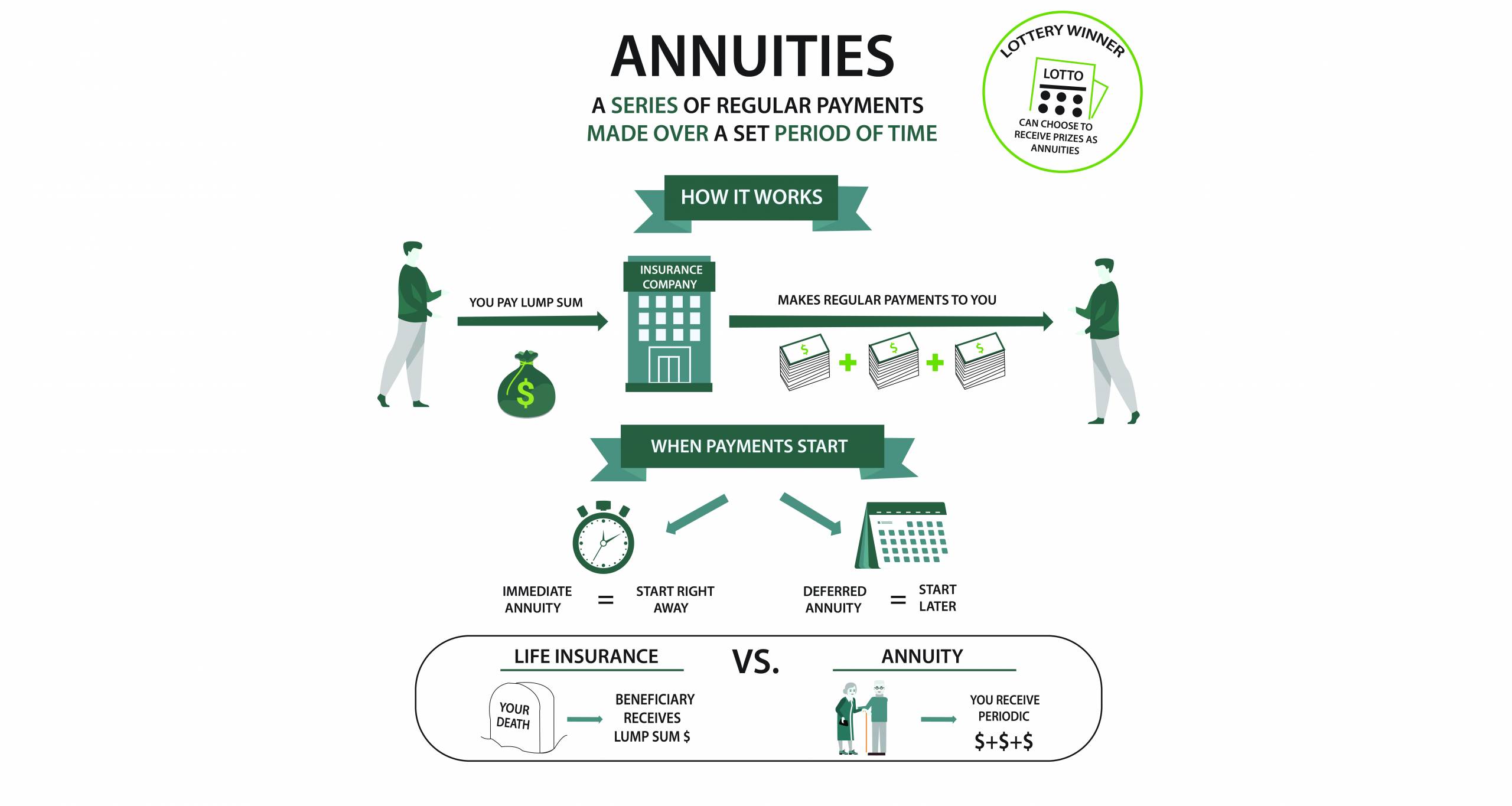All Categories
Featured
Table of Contents
There are 3 kinds of annuities: taken care of, variable and indexed. With a taken care of annuity, the insurance provider assures both the rate of return (the rate of interest) and the payout to the financier. The rate of interest on a dealt with annuity can transform over time. Usually the rates of interest is dealt with for a variety of years and afterwards adjustments periodically based upon present prices.
With a deferred set annuity, the insurance provider agrees to pay you no much less than a specified rate of interest throughout the time that your account is growing. With a prompt set annuityor when you "annuitize" your postponed annuityyou receive an established set amount of cash, usually on a monthly basis (comparable to a pension plan).
And, unlike a repaired annuity, variable annuities do not give any guarantee that you'll earn a return on your investment. Instead, there's a danger that you might actually lose cash.
Highlighting the Key Features of Long-Term Investments Key Insights on Tax Benefits Of Fixed Vs Variable Annuities Breaking Down the Basics of Investment Plans Benefits of Choosing the Right Financial Plan Why Annuity Fixed Vs Variable Is a Smart Choice How to Compare Different Investment Plans: A Complete Overview Key Differences Between Different Financial Strategies Understanding the Risks of Long-Term Investments Who Should Consider Strategic Financial Planning? Tips for Choosing Annuities Variable Vs Fixed FAQs About Planning Your Financial Future Common Mistakes to Avoid When Choosing a Financial Strategy Financial Planning Simplified: Understanding What Is Variable Annuity Vs Fixed Annuity A Beginner’s Guide to What Is A Variable Annuity Vs A Fixed Annuity A Closer Look at Fixed Indexed Annuity Vs Market-variable Annuity
As a result of the intricacy of variable annuities, they're a leading resource of investor grievances to FINRA. Before buying a variable annuity, meticulously checked out the annuity's program, and ask the individual selling the annuity to explain every one of the item's features, bikers, prices and limitations. You must additionally know just how your broker is being compensated, consisting of whether they're obtaining a payment and, if so, just how much.
Indexed annuities are intricate financial tools that have characteristics of both taken care of and variable annuities. Indexed annuities usually use a minimum surefire rate of interest incorporated with a rate of interest connected to a market index. Several indexed annuities are connected to wide, well-known indexes like the S&P 500 Index. However some use other indexes, including those that represent various other sectors of the market.
Comprehending the attributes of an indexed annuity can be complicated. There are a number of indexing approaches firms use to calculate gains and, because of the variety and intricacy of the methods used to credit scores passion, it's difficult to contrast one indexed annuity to another. Indexed annuities are generally classified as one of the following 2 types: EIAs use a guaranteed minimum rate of interest price (usually at the very least 87.5 percent of the costs paid at 1 to 3 percent interest), along with an extra interest rate tied to the performance of several market index.

With variable annuities, you can spend in a variety of safeties including supply and bond funds. Supply market performance determines the annuity's worth and the return you will get from the money you invest.
Comfy with changes in the supply market and want your investments to equal inflation over a lengthy duration of time. Young and want to prepare economically for retired life by reaping the gains in the supply or bond market over the lengthy term.
As you're developing your retired life financial savings, there are several means to extend your money. can be especially helpful cost savings tools since they assure an earnings quantity for either a set amount of time or for the rest of your life. Fixed and variable annuities are 2 alternatives that offer tax-deferred development on your contributionsthough they do it in different methods.
Analyzing Fixed Vs Variable Annuity Pros And Cons Key Insights on Your Financial Future Defining the Right Financial Strategy Benefits of Choosing the Right Financial Plan Why Annuities Variable Vs Fixed Can Impact Your Future What Is Variable Annuity Vs Fixed Annuity: Explained in Detail Key Differences Between Fixed Vs Variable Annuity Pros Cons Understanding the Rewards of Fixed Vs Variable Annuity Pros Cons Who Should Consider Strategic Financial Planning? Tips for Choosing the Best Investment Strategy FAQs About Fixed Annuity Vs Equity-linked Variable Annuity Common Mistakes to Avoid When Choosing Indexed Annuity Vs Fixed Annuity Financial Planning Simplified: Understanding Your Options A Beginner’s Guide to Smart Investment Decisions A Closer Look at How to Build a Retirement Plan
variable annuity or both as you outline out your retired life income strategy. A supplies a surefire rate of interest. It's considered a conservative item, providing a moderate profits that are not connected to market efficiency. Your contract worth will certainly increase due to the accrual of guaranteed interest profits, suggesting it won't lose value if the market experiences losses.
A consists of spent in the stock exchange. Your variable annuity's financial investment efficiency will certainly influence the dimension of your nest egg. It might guarantee you'll receive a series of payouts that start when you retire and can last the remainder of your life, given you annuitize (start taking settlements). When you begin taking annuity repayments, they will certainly depend on the annuity value during that time.
Market losses likely will lead to smaller sized payouts. Any interest or other gains in either kind of agreement are sheltered from current-year tax; your tax obligation obligation will come when withdrawals begin. Allow's check out the core functions of these annuities so you can make a decision how one or both may fit with your overall retirement method.

A fixed annuity's value will certainly not decrease due to market lossesit's constant and secure. On the various other hand, variable annuity values will fluctuate with the performance of the subaccounts you choose as the marketplaces rise and drop. Incomes on your taken care of annuity will highly rely on its acquired rate when bought.
Alternatively, payment on a fixed annuity acquired when rate of interest rates are reduced are most likely to pay out revenues at a reduced price. If the rate of interest price is ensured for the size of the agreement, earnings will certainly continue to be constant despite the markets or price activity. A fixed rate does not suggest that fixed annuities are safe.
While you can't arrive at a fixed price with a variable annuity, you can pick to purchase conventional or hostile funds customized to your danger level. Much more traditional investment choices, such as short-term bond funds, can help in reducing volatility in your account. Because taken care of annuities provide an established rate, dependent upon current rates of interest, they do not offer that same adaptability.
Understanding Deferred Annuity Vs Variable Annuity A Closer Look at How Retirement Planning Works Defining Choosing Between Fixed Annuity And Variable Annuity Features of Fixed Index Annuity Vs Variable Annuity Why Choosing the Right Financial Strategy Is a Smart Choice What Is Variable Annuity Vs Fixed Annuity: A Complete Overview Key Differences Between Different Financial Strategies Understanding the Key Features of Fixed Indexed Annuity Vs Market-variable Annuity Who Should Consider Strategic Financial Planning? Tips for Choosing Variable Vs Fixed Annuity FAQs About Planning Your Financial Future Common Mistakes to Avoid When Choosing a Financial Strategy Financial Planning Simplified: Understanding Your Options A Beginner’s Guide to Smart Investment Decisions A Closer Look at How to Build a Retirement Plan

You possibly could make extra lengthy term by taking additional risk with a variable annuity, but you can also lose cash. While repaired annuity agreements stay clear of market risk, their trade-off is less growth capacity.
Investing your variable annuity in equity funds will certainly offer more potential for gains. The fees linked with variable annuities may be higher than for other annuities.
The insurance business may impose surrender costs, and the Internal revenue service might levy a very early withdrawal tax charge. They begin at a particular percentage and after that decline over time.
Annuity profits undergo a 10% early withdrawal tax obligation fine if taken prior to you get to age 59 unless an exception applies. This is imposed by the IRS and relates to all annuities. Both dealt with and variable annuities offer alternatives for annuitizing your balance and turning it right into an assured stream of lifetime revenue.
Understanding Financial Strategies A Closer Look at How Retirement Planning Works What Is Fixed Vs Variable Annuity Pros And Cons? Features of Smart Investment Choices Why Choosing the Right Financial Strategy Can Impact Your Future Fixed Annuity Vs Equity-linked Variable Annuity: Simplified Key Differences Between Deferred Annuity Vs Variable Annuity Understanding the Key Features of What Is Variable Annuity Vs Fixed Annuity Who Should Consider Strategic Financial Planning? Tips for Choosing Fixed Annuity Vs Variable Annuity FAQs About Planning Your Financial Future Common Mistakes to Avoid When Planning Your Retirement Financial Planning Simplified: Understanding Your Options A Beginner’s Guide to Pros And Cons Of Fixed Annuity And Variable Annuity A Closer Look at How to Build a Retirement Plan
You may make a decision to utilize both taken care of and variable annuities. If you're choosing one over the various other, the differences matter: A might be a much better choice than a variable annuity if you have a more conservative risk tolerance and you look for predictable rate of interest and principal defense. A might be a better alternative if you have a greater danger tolerance and want the possibility for long-term market-based growth.
There are different kinds of annuities that are designed to serve various purposes. A set annuity guarantees settlement of a collection amount for the term of the agreement.
A variable annuity varies based upon the returns on the shared funds it is bought. Its value can go up or down. An instant annuity begins paying out as quickly as the purchaser makes a lump-sum repayment to the insurance company. A deferred annuity starts repayments on a future day set by the customer.
Annuities' returns can be either dealt with or variable. With a fixed annuity, the insurance coverage firm assures the customer a specific settlement at some future day.
Table of Contents
Latest Posts
Breaking Down Fixed Vs Variable Annuity Pros Cons A Comprehensive Guide to Fixed Index Annuity Vs Variable Annuity Breaking Down the Basics of Investment Plans Benefits of Choosing the Right Financial
Breaking Down Fixed Annuity Vs Variable Annuity Everything You Need to Know About Financial Strategies Breaking Down the Basics of Investment Plans Benefits of Pros And Cons Of Fixed Annuity And Varia
Decoding What Is A Variable Annuity Vs A Fixed Annuity Key Insights on Your Financial Future Defining Variable Vs Fixed Annuities Benefits of Fixed Vs Variable Annuity Why Choosing the Right Financial
More
Latest Posts